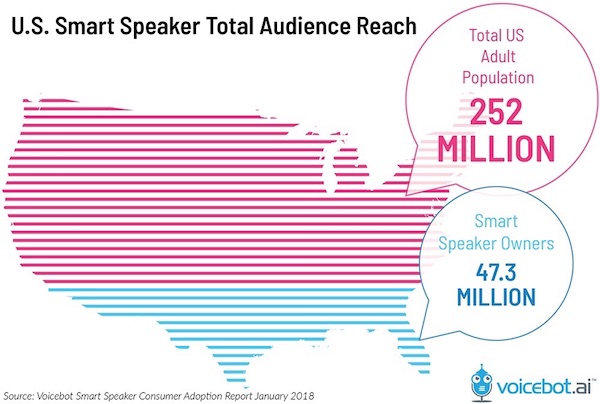New Voicebot Report Says Nearly 20% of U.S. Adults Have Smart Speakers
Voicebot collaborated with PullString and RAIN Agency to conduct an in-depth national survey of 1,057 U.S. adults to find out more about who owns smart speakers, which products they prefer and what they do with them. The result is the Voicebot Smart Speaker Consumer Adoption Report 2018, sponsored by PullString and RAIN.
The top level finding is that 18.8% of U.S. adults reported having a smart speaker and that translates into about 47.3 million people. Based on comments from people that don’t own smart speakers, consumer adoption is likely to grow nearly 50% in 2018. You can download the full report here.

29 Pages, 23 Charts and More
The 29-page report includes 23 charts. Additional data points and insights are incorporated into analysis in five categories.
- Smart Speaker Ownership Data: how many users, what devices they use, gender breakdown, smartphone ownership and related data. We even discuss the relationship between iPhone ownership and smart speaker preferences.
- Smart Speaker Use Cases: what are smart speakers used for and how frequently. There is a top seven set of use cases that are forming consumer habits today. This is the first data to expose which use cases are simply tried and abandoned and which are incorporated into daily life.
- Voice Commerce: how many people have tried voice shopping, what percentage are regular users and what smart speakers do they own. You probably wouldn’t guess which device owners are more likely to have shopped using voice or what percent of smart speaker owners engage in voice commerce monthly.
- Voice App Discovery: how many users have tried third-party skills and voice apps and how do they find them. Also, how many are leaving reviews and what that means for voice app publishers.
- Perspectives of Non-Owners: why haven’t they purchased a smart speaker and how many expect to buy one in 2018. Guess what? Privacy concerns are not very high on the list when it comes to reasons for not purchasing a device and new buyers could grow the smart speaker user base by 50% in 2018. In addition, many are interested in the Apple HomePod.
Rapid Adoption and Changing Consumer Behavior
Greg Hedges, VP of emerging experiences for RAIN, was part of the research team and he was stuck by both the smart speaker and voice assistant adoption rate as well as the impact on consumer habits.
Consumers continue to flock toward voice technology in staggering rates, which demonstrates not only the lightning in a bottle that these smart speakers (Echo/Dot and Google Home/Mini) have generated, but ultimately showcase Voice’s impact as a larger behavioral movement. The question for those sitting on the sidelines can no longer can be, “When should I start thinking about this?” but instead, “What’s the best way to get started now?”
PullString President and COO Michael Fitzpatrick also participated in the study and was struck by how this consumer shift to voice is creating urgency for brands and agencies.
The explosion of smart speaker adoption is giving Brands and Agencies a new conversational voice to engage their consumers. With nearly 20% of American adults already adopting these platforms, organizations without a voice strategy are already being left behind.
Brands and agencies need to be where the consumers are and increasingly that means voice engagement. As I said in my keynote address to the Smart Voice Summit in Paris last month, if brands don’t have a voice app, they are literally silent on the fastest growing technology platform today. Let us know what you think or ask questions on Twitter by reaching out to @bretkinsella, @voicebotai, @PullStringInc, @RAINagency.
Follow @bretkinsella
Amazon Echo Maintains Large Market Share Lead in U.S. Smart Speaker User Base
Amazon Echo and Google Home European Smart Speaker Sales Approach 6.5 Million Units in 2017
Voicebot Podcast Episode 21 – Oren Jacob, CEO Pullstring Talks Pixar, Alexa and Sponge Bob









